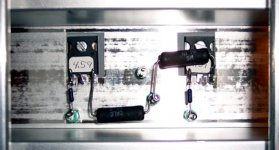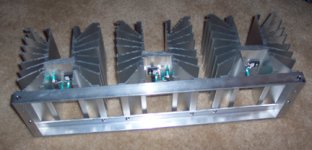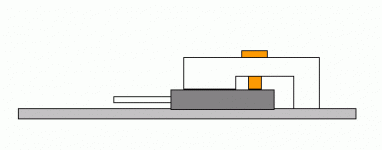I am finally assembling my Aleph 2's. At this point I am in the process of wiring up the 6 heatsinks of one amp(2 groups of three) using turrett terminals that screw into threaded holes in the sinks. I really like these terminals and the ease of using them would cause me to consider building an Aleph using all point to point wiring in the future.
I began to wonder what the correct hardware is that IR reccommends....does anyone know.....? I am just using a standard 6/32 screw but shouldone use a cup washer, lockwasher or what? The Silicon insulators are only temporary!!
Thanks,
Mark
I began to wonder what the correct hardware is that IR reccommends....does anyone know.....? I am just using a standard 6/32 screw but shouldone use a cup washer, lockwasher or what? The Silicon insulators are only temporary!!
Thanks,
Mark
Attachments
using turrett terminals
What are turret terminals? And where can you buy them?
I like the way you mounted the resitors by using terminals. I was also thinking about going point to point for my AlpehX. But I didn't like the idea that the resistors are floating and not mounted to something.
I like the idea of using a metal bar across the fet with a screw at each end and a piece of something soft between the bar and fet. That way you can put the pressure right where the die is in the fet, rather than using the screw hole which tends to pull down one end and make the other end that has the die come up a little. Have a look at the pics on this page http://diyaudio.com/forums/showthread.php?s=&threadid=3891&perpage=15&pagenumber=2
They are hole-less TO-247's but you will see what I mean.
They are hole-less TO-247's but you will see what I mean.
The metal bar mounting scheme is the best way ofcourse.. However, as long as you have adequate heatsinks and running the devices well within their SOA, I wouldn't bother.
I always use a flat washer and a springloaded one.
Here's some useful info: http://sound.westhost.com/heatsinks.htm
😉
I always use a flat washer and a springloaded one.
Here's some useful info: http://sound.westhost.com/heatsinks.htm
😉
Thanks for the advice guys. Not sure if I have room to use a flat metal bar, but I am getting better heatsink pads and this may be one of the few Aleph 2's that is over heatsinked!! I am using two banks of these sinke per amp with two devices per sink.
Mark
Mark
Attachments
I recommend a nice wide washer on top.
The TO247 case has good support at the hole, and you
just want to avoid cranking down too hard. We use
torque wrenches set at 8 inch-pounds.
The TO247 case has good support at the hole, and you
just want to avoid cranking down too hard. We use
torque wrenches set at 8 inch-pounds.
Nelson Pass said:I recommend a nice wide washer on top.
The TO247 case has good support at the hole, and you
just want to avoid cranking down too hard. We use
torque wrenches set at 8 inch-pounds.
Nelson,
Does the XA use TO-247 devices, or are you using TO-3 devices like x series?
I like the way that this is done:
http://www.passlabs.com/images/product/x250rail.jpg
--
Brian
For those who are interested in some documentation on
mounting power devices it may be worth looking at Section 5
in http://www.onsemi.com/pub/Collateral/HB206-D.PDF
The document as a whole is about voltage regulators, but
the info on mounting of power devices is quite detailed and
should apply to transistors as well.
mounting power devices it may be worth looking at Section 5
in http://www.onsemi.com/pub/Collateral/HB206-D.PDF
The document as a whole is about voltage regulators, but
the info on mounting of power devices is quite detailed and
should apply to transistors as well.
Hi Nelson,
Thanks for the tourque specs. I appreciate your reply to this question, and I have done mine exactly as you specified. My main concern was that with too much torque and the repeated thermal expansion/contraction that things inside the transistor may break down. To little torque and thermal transfer suffers. I can remember this thermal stress problem from the ole days(1973) in the Hi-Fi repair shop with the TO-220 output devices. Many H-K and Pioneer receivers suffered from this problem.
As far as the Turret Terminals go I bought mine at Ra-Elco in Salt Lake City. You can get more by calling 801-487-7749. Ask for Robert or Monty. I really like them alot and they are a joy to solder to. Mine cost me 58 cents each. They stock both male, and Female 6/32 thread. I believe they are made by Concord Electronics in N.Y. http://www.concord-elex.com/
I also like Circlotrons metal clamp idea but its very labor intensive to make them.
Mark Gulbrandsen
Salt Lake City, UT
Thanks for the tourque specs. I appreciate your reply to this question, and I have done mine exactly as you specified. My main concern was that with too much torque and the repeated thermal expansion/contraction that things inside the transistor may break down. To little torque and thermal transfer suffers. I can remember this thermal stress problem from the ole days(1973) in the Hi-Fi repair shop with the TO-220 output devices. Many H-K and Pioneer receivers suffered from this problem.
As far as the Turret Terminals go I bought mine at Ra-Elco in Salt Lake City. You can get more by calling 801-487-7749. Ask for Robert or Monty. I really like them alot and they are a joy to solder to. Mine cost me 58 cents each. They stock both male, and Female 6/32 thread. I believe they are made by Concord Electronics in N.Y. http://www.concord-elex.com/
I also like Circlotrons metal clamp idea but its very labor intensive to make them.
Mark Gulbrandsen
Salt Lake City, UT
just don't use the silicon impregnated washers
use mica, it has a much lower thermal resistance
Mark hathaway
use mica, it has a much lower thermal resistance
Mark hathaway
There are silicon washers with better thermal conductivity than
mica, see eg. the reference I linked to earlier in this thread.
Also looking in the catalouge from my local supplier, mica washers
are stated as <1 deg C/W, and the two types of silicon washers
are < 0.75 and < 0.4 deg C/W. Thickness will affect the figurs,
of course, and there may be other factors as well.
mica, see eg. the reference I linked to earlier in this thread.
Also looking in the catalouge from my local supplier, mica washers
are stated as <1 deg C/W, and the two types of silicon washers
are < 0.75 and < 0.4 deg C/W. Thickness will affect the figurs,
of course, and there may be other factors as well.
...lastname
Hey....
You have a norwegian last name... Gulbrandsen
Gulbrandsen is a common lastname here in Norway, do you know something about your norwegian origin??
Hey....
You have a norwegian last name... Gulbrandsen
Gulbrandsen is a common lastname here in Norway, do you know something about your norwegian origin??
didn't realise the silicon washers had improved so much
I never realised the bog standard silicon washer had improved to equal mica. Last silicon washers I'd seen were 1 deg c/w.!!
The problem with most mica is the manufacturers make it WAAAAAAAAY too thick, i've had some I could get 10 pieces out of with a razor. Thin mica is good for 0.4 dec c/w
Still like the ~0.09 c/w for a greased device without a washer on the bare heatsink.
Mark Hathaway
I never realised the bog standard silicon washer had improved to equal mica. Last silicon washers I'd seen were 1 deg c/w.!!
The problem with most mica is the manufacturers make it WAAAAAAAAY too thick, i've had some I could get 10 pieces out of with a razor. Thin mica is good for 0.4 dec c/w
Still like the ~0.09 c/w for a greased device without a washer on the bare heatsink.
Mark Hathaway
IRF's recommendations
The guidelines recommended by International Rectifier can be found here in their application note AN-1012: http://www.irf.com/technical-info/appnotes/an-1012.pdf
The guidelines recommended by International Rectifier can be found here in their application note AN-1012: http://www.irf.com/technical-info/appnotes/an-1012.pdf
Hi Gunderz!!
Sorry I did not see your posting before for some reason. I travel sometimes so if I'm away I may have missed it. Gulbrandsen is indeed a common Norwegian name....sort of like Smith I guess.There are a number of Gulbrandsens around here too, even one with my first name.
I only know a little bit about my Norwegian background. My Great grandfather was the first one over here I think in the late 1800's/ early 1900's. My dad knows pretty much the whole story plus I can go downtown and research it all very easily at the Mormon Family Research Library. Even though most people in the world are not Mormon they have info on just about everyone in the world on file there and its pretty much the best, and easiest place in the world for doing this sort of thing. If only I had time........
Mark G.
Sorry I did not see your posting before for some reason. I travel sometimes so if I'm away I may have missed it. Gulbrandsen is indeed a common Norwegian name....sort of like Smith I guess.There are a number of Gulbrandsens around here too, even one with my first name.
I only know a little bit about my Norwegian background. My Great grandfather was the first one over here I think in the late 1800's/ early 1900's. My dad knows pretty much the whole story plus I can go downtown and research it all very easily at the Mormon Family Research Library. Even though most people in the world are not Mormon they have info on just about everyone in the world on file there and its pretty much the best, and easiest place in the world for doing this sort of thing. If only I had time........
Mark G.
Updated Info
Since this thread and the links inside are very old. And since the question of proper mounting of semiconductor devices is still relevant, I found this link. Hey, the graphs are even in color.
https://www.fairchildsemi.com/application-notes/AN/AN-4166.pdf
Since this thread and the links inside are very old. And since the question of proper mounting of semiconductor devices is still relevant, I found this link. Hey, the graphs are even in color.
https://www.fairchildsemi.com/application-notes/AN/AN-4166.pdf
- Status
- Not open for further replies.
- Home
- Amplifiers
- Pass Labs
- Proper mounting of TO-247 Devices



